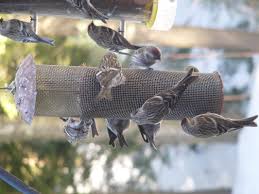Here's the
USDA's Fact Sheet on mold in food:
Molds On Food: Are They Dangerous?
Some molds cause allergic reactions and respiratory problems. And a few molds, in the right conditions, produce "mycotoxins," poisonous substances that can make people sick. When you see mold on food, is it safe to cut off the moldy part and use the rest? To find the answer to that question, delve beneath the surface of food to where molds take root.
What Are Molds?
Molds are microscopic fungi that live on plant or animal matter. No one knows how many species of fungi exist, but estimates range from tens of thousands to perhaps 300,000 or more. Most are filamentous (threadlike) organisms and the production of spores is characteristic of fungi in general. These spores can be transported by air, water, or insects.
Unlike bacteria that are one-celled, molds are made of many cells and can sometimes be seen with the naked eye. Under a microscope, they look like skinny mushrooms. In many molds, the body consists of:
- root threads that invade the food it lives on,
- a stalk rising above the food, and
- spores that form at the ends of the stalks.
The spores give mold the color you see. When airborne, the spores spread the mold from place to place like dandelion seeds blowing across a meadow.
Molds have branches and roots that are like very thin threads. The roots may be difficult to see when the mold is growing on food and may be very deep in the food. Foods that are moldy may also have invisible bacteria growing along with the mold.
[
Top of Page]
Are Some Molds Dangerous?
Yes, some molds cause allergic reactions and respiratory problems. And a few molds, in the right conditions, produce “mycotoxins,” poisonous substances that can make you sick.
[
Top of Page]
Are Molds Only on the Surface of Food?
No, you only see part of the mold on the surface of food -- gray fur on forgotten bologna, fuzzy green dots on bread, white dust on Cheddar, coin-size velvety circles on fruits, and furry growth on the surface of jellies. When a food shows heavy mold growth, “root” threads have invaded it deeply. In dangerous molds, poisonous substances are often contained in and around these threads. In some cases, toxins may have spread throughout the food.
[
Top of Page]
Where Are Molds Found?
Molds are found in virtually every environment and can be detected, both indoors and outdoors, year round. Mold growth is encouraged by warm and humid conditions. Outdoors, they can be found in shady, damp areas or places where leaves or other vegetation are decomposing. Indoors, they can be found where humidity levels are high.
Molds form spores which, when dry, float through the air and find suitable conditions where they can start the growth cycle again.
[
Top of Page]
What Are Some Common Foodborne Molds?
Molds most often found on meat and poultry are
Alternaria, Aspergillus, Botrytis, Cladosporium, Fusarium, Geotrichum, Monilia, Manoscus, Mortierella, Mucor, Neurospora, Oidium, Oosproa, Penicillium, Rhizopus and
Thamnidium. These molds can also be found on many other foods.
[
Top of Page]
What Are Mycotoxins?
Mycotoxins are poisonous substances produced by certain molds found primarily in grain and nut crops, but are also known to be on celery, grape juice, apples, and other produce. There are many of them and scientists are continually discovering new ones. The Food and Agriculture Organization (FAO) of the United Nations estimates that 25% of the world's food crops are affected by mycotoxins, of which the most notorious are aflatoxins.
[
Top of Page]
What is Aflatoxin?
Aflatoxin is a cancer-causing poison produced by certain fungi in or on foods and feeds, especially in field corn and peanuts. They are probably the best known and most intensively researched mycotoxins in the world. Aflatoxins have been associated with various diseases, such as aflatoxicosis in livestock, domestic animals, and humans throughout the world. Many countries try to limit exposure to aflatoxin by regulating and monitoring its presence on commodities intended for use as food and feed. The prevention of aflatoxin is one of the most challenging toxicology issues of present time.
[
Top of Page]
How Does the U.S. Government Control Aflatoxins?
Aflatoxins are considered unavoidable contaminants of food and feed, even where good manufacturing practices have been followed. The U.S. Food and Drug Administration and the USDA monitor peanuts and field corn for aflatoxin and can remove any food or feed with unacceptable levels of it.
[
Top of Page]
Is Mushroom Poisoning Caused by Molds?
No, it is due to the toxin produced by the fungi, which are in the same family as molds. Mushroom poisoning is caused by the consumption of raw or cooked mushrooms, which are higher-species of fungi. The term “toadstool” (from the German “Todesstuhl” -- death's stool) is commonly given to poisonous mushrooms, but there is no general rule of thumb for distinguishing edible mushrooms from poisonous toadstools. The toxins that cause mushroom poisoning are produced naturally by the fungi. Most mushrooms that cause human poisoning cannot be made safe by cooking, canning, freezing, or any other processing. The only way to avoid poisoning is not to eat poisonous mushrooms.
[
Top of Page]
Are Any Food Molds Beneficial?
Yes, molds are used to make certain kinds of cheeses and can be on the surface of cheese or be developed internally. Blue veined cheese such as Roquefort, blue, Gorgonzola, and Stilton are created by the introduction of
P. roqueforti or
Penicillium roqueforti spores. Cheeses such as Brie and Camembert have white surface molds. Other cheeses have both an internal and a surface mold. The molds used to manufacture these cheeses are safe to eat.
[
Top of Page]
Why Can Mold Grow in the Refrigerator?
While most molds prefer warmer temperatures, they can grow at refrigerator temperatures, too. Molds also tolerate salt and sugar better than most other food invaders. Therefore, molds can grow in refrigerated jams and jelly and on cured, salty meats -- ham, bacon, salami, and bologna.
[
Top of Page]
How Can You Minimize Mold Growth?
Cleanliness is vital in controlling mold. Mold spores from affected food can build up in your refrigerator, dishcloths, and other cleaning utensils.
- Clean the inside of the refrigerator every few months with 1 tablespoon of baking soda dissolved in a quart of water. Rinse with clear water and dry. Scrub visible mold (usually black) on rubber casings using 3 teaspoons of bleach in a quart of water.
- Keep dishcloths, towels, sponges, and mops clean and fresh. A musty smell means they’re spreading mold around. Discard items you can’t clean or launder.
- Keep the humidity level in the house below 40%.
[
Top of Page]
Don’t Buy Moldy Foods
Examine food well before you buy it. Check food in glass jars, look at the stem areas on fresh produce, and avoid bruised produce. Notify the store manager about mold on foods!
Fresh meat and poultry are usually mold free, but cured and cooked meats may not be. Examine them carefully. Exceptions: Some salamis -- San Francisco, Italian, and Eastern European types -- have a characteristic thin, white mold coating which is safe to consume; however, they shouldn’t show any other mold. Dry-cured country hams normally have surface mold that must be scrubbed off before cooking.
[
Top of Page]
Must Homemade Shelf-Stable Preserves be Water-Bath Processed?
Yes, molds can thrive in high-acid foods like jams, jellies, pickles, fruit, and tomatoes. But these microscopic fungi are easily destroyed by heat processing high-acid foods at a temperature of 212 °F in a boiling water canner for the recommended length of time. For more information about processing home-canned foods, go to the National Center for Home Food Preservation at:
www.uga.edu/nchfp/.
[
Top of Page]
How Can You Protect Food from Mold?
- When serving food, keep it covered to prevent exposure to mold spores in the air. Use plastic wrap to cover foods you want to stay moist -- fresh or cut fruits and vegetables, and green and mixed salads.
- Empty opened cans of perishable foods into clean storage containers and refrigerate them promptly.
- Don’t leave any perishables out of the refrigerator more than 2 hours.
- Use leftovers within 3 to 4 days so mold doesn’t have a chance to grow.
[
Top of Page]
How Should You Handle Food with Mold on It?
Buying small amounts and using food quickly can help prevent mold growth. But when you see moldy food:
- Don’t sniff the moldy item. This can cause respiratory trouble.
- If food is covered with mold, discard it. Put it into a small paper bag or wrap it in plastic and dispose in a covered trash can that children and animals can’t get into.
- Clean the refrigerator or pantry at the spot where the food was stored.
- Check nearby items the moldy food might have touched. Mold spreads quickly in fruits and vegetables.
- See the attached chart “Moldy Food: When to Use, When to Discard.”
NOTE: THERE'S A CHART ON THE USDA WEBSITE, BUT IT WON'T COPY PROPERLY HERE, SO IT'S ATTACHED AS A PDF. 













